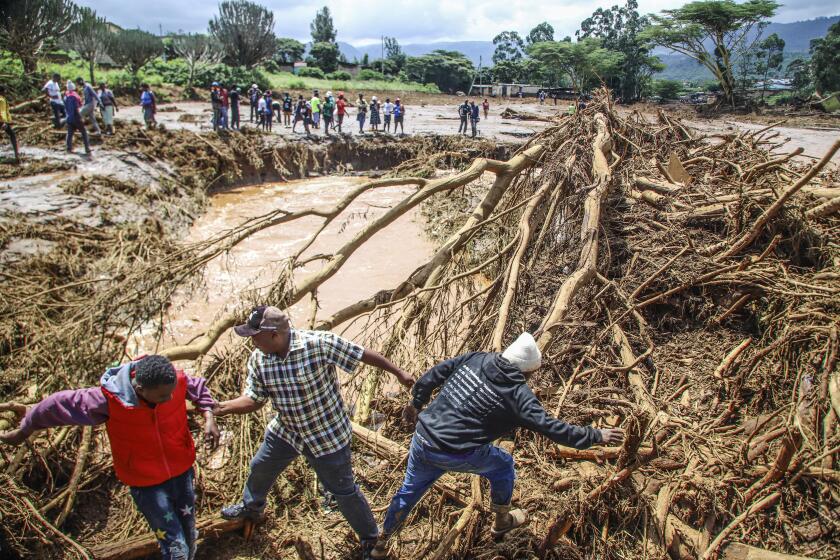To Iraq’s woes, add early cholera wave
Iraq has reported five cases of cholera among children in the last three weeks, a worrying sign as summer sets in and the war leaves sewage and sanitation systems a shambles.
All of the cases were among children younger than 12 in the southern city of Najaf and were reported by medical officials on alert for signs of the potentially lethal ailment, Claire Hajaj of the United Nations Children’s Fund, or UNICEF, said Tuesday.
Cholera, which is caused by bacteria in contaminated water, is easily treatable, but if not treated it can cause rapid dehydration and death. Cholera pandemics have killed tens of thousands of people worldwide, most recently in South America in the early 1990s.
Although the number of cases so far is low, and none has been fatal, the emergence of cholera this early in the year is ominous, Hajaj said. Cholera outbreaks usually don’t arise until July, when temperatures can soar above 120 degrees.
As the temperature rises, Iraq’s chronic electricity shortages make it difficult to operate pumps at sewage and drinking-water treatment plants, creating a dangerous mix of desperate people and dirty water.
Already, the number of diarrhea cases, which can be a sign of cholera, is twice the seasonal average, Hajaj said.
“Water is an enormous need and people take it where they can get it, and they are getting it from places where it is not always clean,” she said.
In the capital alone, at least 135,000 residents depend on water from tanker trucks. Tens of thousands of Iraqis bore holes into the ground outside their houses and businesses and pump their own ground water.
That’s what Mohammed Salman and Hussein Kadhum were doing Tuesday on a busy street in Baghdad’s Karada district, a middle-class enclave. The two were looking for a water source for their food store. Using a shovel and a manual auger, they had bored a hole 13 feet deep after working half the day. Their aim was to draw water directly from the aquifer of the Tigris River, which flows through Baghdad.
“We don’t ask the government. We do it because we have no other choice,” Salman said when asked whether he feared municipal officials would close his well. He measured his progress by lowering a long pole into the roughly foot-wide hole. After drawing the pole back out, Salman and Kadhum resumed their laborious twisting of the auger.
The water shortage is one additional daily hardship Iraqis have had to endure since the U.S.-led invasion in March 2003, which toppled dictator Saddam Hussein and brought hopes of a better life.
Although many Iraqis lacked uninterrupted supplies of safe drinking water under Hussein, they did not risk being blown up by car bombs or caught in sectarian warfare if they left their homes to buy bottled water -- which many can no longer afford.
Municipal water, meanwhile, often comes through cracked and dirty pipes that were neglected under Hussein and have been further damaged by four years of war.
Efforts to repair the infrastructure are hampered by insurgent attacks on municipal workers, who are targeted for working on behalf of the U.S.-backed government.
“It’s a combination of a bad situation made worse,” Hajaj said.
In Baghdad’s residential neighborhoods, saucer-sized holes with rubber hoses emerging from them are evidence of efforts to make do. Most are dug into sidewalks, the hoses snaking from the ground and beneath garden walls. Some people try to conceal them by digging the wells beneath bushes, or by placing something atop the holes.
The well that serves 16-year-old Hassan Hadi’s house is in the front garden. It was dug during Hussein’s era, just to water the small lawn and a fruit tree, but Hassan says his family now uses it to provide water for washing and to help neighbors who do not have their own wells.
The municipality also provides water through a government-installed well in the garden, but water from it is available only from midnight to about 6 a.m. The family is afraid to drink it, for fear of becoming ill, and buys bottled mineral water, Hassan said.
At another house nearby, a woman who gave her name as Umm Shams draws water from a well she dug a year ago when her taps began to run dry.
“I don’t know exactly where it comes from,” she said of the water that surges through the hose. “Now it smells,” she added, wrinkling her nose.
Umm Shams, a biochemist who works for the Health Ministry, says the government insists that water provided through municipal wells is safe for drinking. But she laughed and waved her hand back and forth when asked whether she would drink it.
“Not all people are aware of the problem,” she said. “I know some people are drinking from the wells because they don’t have enough money to buy mineral water.”
Umm Shams said she spends about $3 a day for bottled drinking water for herself and family members living in the house -- her 11-year-old daughter, her brother and sister-in-law, and their two daughters. One of them, 6-year-old Kamer, became severely ill two years ago after drinking water from municipal taps, Umm Shams said.
She recently has taken in a third niece, Aisha, 12, because her home in the volatile Baghdad neighborhood of Dora has neither running water nor electricity most of the time. It is too dangerous for residents of Dora to go out to buy water, Umm Shams said, as Aisha stood in a corner munching Cheetos.
Even Umm Shams’ home has been without electricity for two days, she said, looking at the still fan hanging from the ceiling of the small, neat living room.
The U.N. estimates that only 17% of Iraqi sewage is being treated because of nonworking sewage treatment plants. Like water treatment plants, they operate on electricity.
Most sewage pours into the Tigris and Euphrates rivers.
Hajaj said the fact that water is being trucked to many residents shows the slow pace of humanitarian progress in Iraq’s situation.
“Water tankering ... is seen to be an emergency operation. You do it when there is a crisis,” she said. “We are four years into the crisis, and what donors are increasingly asking is why. Why is there still this need?”
--
More to Read
Start your day right
Sign up for Essential California for news, features and recommendations from the L.A. Times and beyond in your inbox six days a week.
You may occasionally receive promotional content from the Los Angeles Times.







